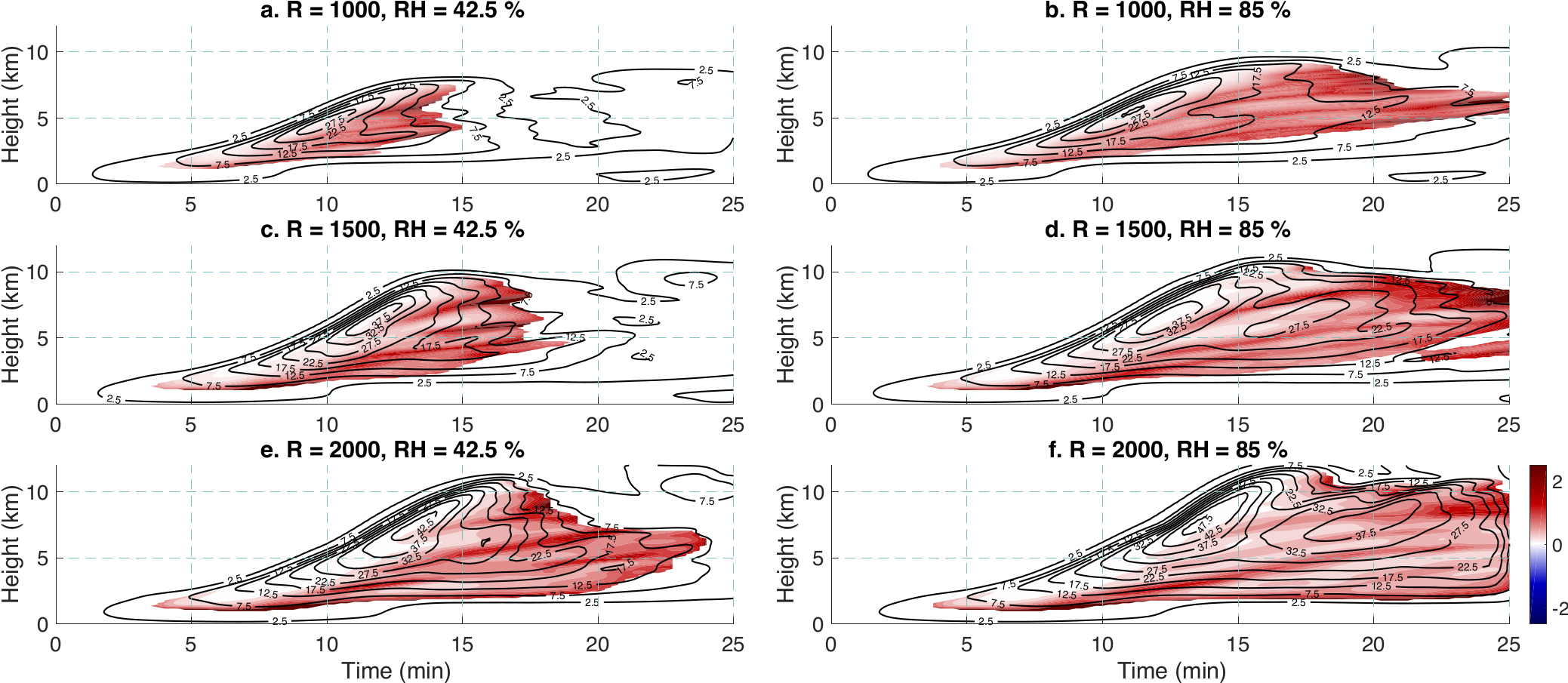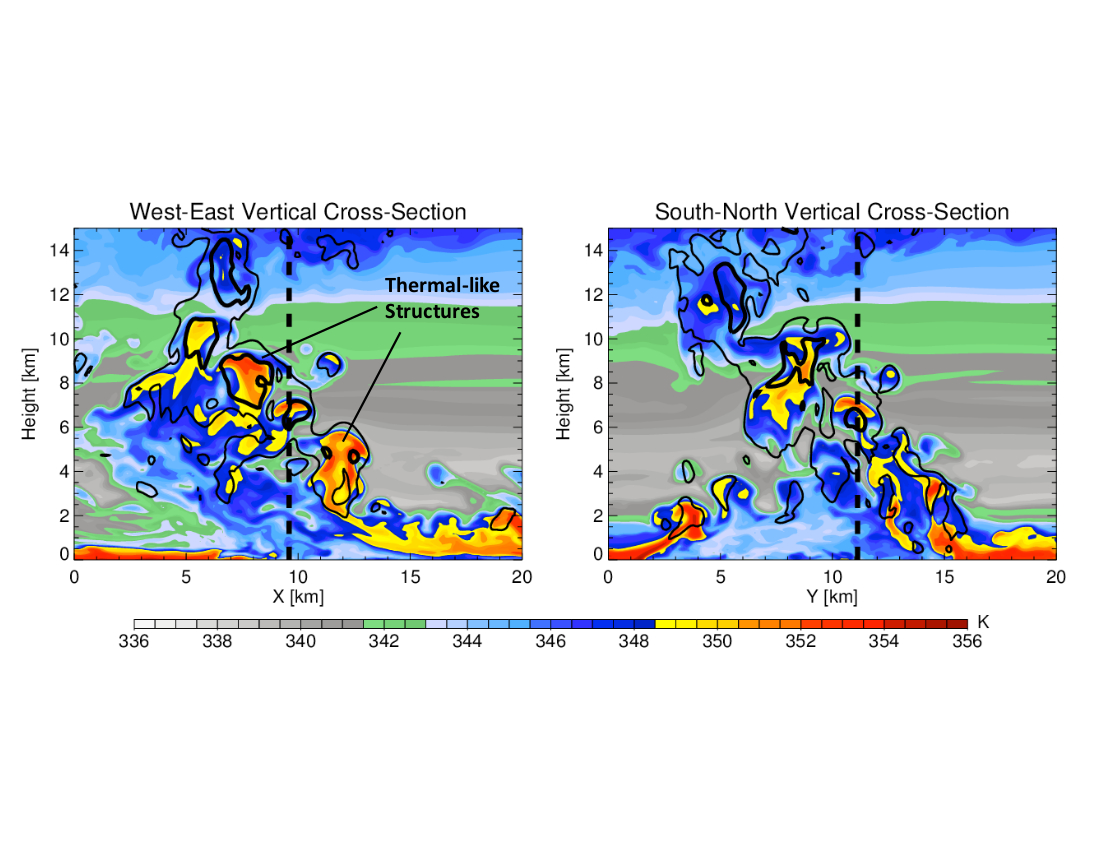Thermals, thermal chains, and plumes: what controls the basic structure of cumulus convection?
Submitter
Morrison, Hugh Clifton
— University Corporation for Atmospheric Research
Peters, John Michael
— Naval Postgraduate School
Area of Research
Vertical Velocity
Journal Reference
Morrison H, J Peters, A Varble, W Hannah, and S Giangrande. 2020. "Thermal Chains and Entrainment in Cumulus Updrafts. Part I: Theoretical Description." 77(11), 10.1175/JAS-D-19-0243.1.
Peters J, H Morrison, A Varble, W Hannah, and S Giangrande. 2020. "Thermal Chains and Entrainment in Cumulus Updrafts. Part II: Analysis of Idealized Simulations." 77(11), 10.1175/jas-d-19-0244.1.
Science

Figure 2. Time-height diagram of fractional entrainment rate (shading, per km) and level-maximum vertical velocity (black contours at intervals of 5 m/s, starting at 2.5 m/s). The left panels show large-eddy simulations with environmental relative humidity of 42.5%. The right panels show large-eddy simulations with environmental relative humidity of 85%. Initial bubble radii are 1000 m (top panels), 1500 m (middle panels), and 2000 m (bottom panels), which generate clouds of different widths. The strongly banded structures seen after about 12 min in the left lower and especially left center panels correspond to locally enhanced entrainment associated with rising successive thermals in the “thermal chain” structure. The convective structure in the right center and especially right lower panels is more plume-like because of the higher relative humidity environment and wider initial updraft bubbles. From journal.

Figure 1. Perpendicular vertical cross-sections through a LES of the 23-24 January 2006 deep convection case from the Tropical Warm Pool-International Cloud Experiment (TWP-ICE) with a horizontal grid spacing of 100 m, reproduced from Varble et al. (2014). These plots illustrate the “thermal chain” structure consisting of a series of rising thermals. Equivalent potential temperature, which provides a measure of cloud dilution (roughly, higher values imply less diluted air) is shaded (K) and vertical velocity is in black contours at intervals of 5 and 15 m/s. The dashed lines show the location of the other cross-section. As indicated, distinctive thermal structures rising in succession are seen by the localized areas of large equivalent potential temperature and vertical velocity between about 2 and 12 km in height. From journal.
Two basic conceptual models have traditionally served as a basis for understanding moist convection in the atmosphere: plumes and thermals. Plumes consist of a “chimney” of rising air, while thermals are discrete rising bubbles. Whether cumulus convection is more plume-like or thermal-like has important implications for how clouds entrain and mix with environmental air as well as their vertical velocity structure. We use a simple theoretical model and high-resolution large-eddy simulation (LES) to explore convective structure. From these results we propose that a continuum exists between thermals and plumes, with a transition between the two characterized by “thermal chains” -- a succession of rising thermals. We show that thermal chains occur over a wide range of conditions.
Impact
This study develops a conceptual model of cumulus convective structure, highlighting how it is influenced by relative humidity of the environment, cloud width, and convective available potential energy. We focus in particular on implications for cloud entrainment and dilution. This work can help inform convection parameterizations, especially given that entrainment remains one of the major uncertainties in current parameterizations. There are also implications for interpreting the behavior of “convection-permitting” models with a horizontal grid scale of about 1-5 km, which can represent but not fully resolve convective updrafts. Convective clouds in these models are generally too wide and appear plume-like. Finally, the prevalence of these thermal-like cloud structures and their importance in driving entrainment as well as dynamics-microphysics coupling highlights the need for high-temporal-and-spatial-resolution (order a few hundred meters and 1 min) observations of the flow structures within convective clouds.
Summary
From a simple theoretical model and large set of idealized numerical simulations, including LES, we explore the conditions that influence convective cloud structure. In dry environments and/or narrow cloud width, the structure consists of individual rising thermals, whereas wide updrafts in moist environments resemble plumes. An increase in convective available potential energy also contributes to a shift from thermal to plume-like updrafts. The transition between an individual rising thermal and a plume consists of an organized succession of rising thermals -- a “thermal chain”. This transition is driven by local pulses of enhanced entrainment rate below updraft’s vertical velocity maximum. In a dry environment or for a narrow cloud this leads to substantial local reduction of the cloud’s buoyancy, and consequently the updraft flow above the level of reduced buoyancy separates from below. This leads to a succession of rising thermals. This mechanism is inherently a feature of moist convection, driven by feedback between the flow structure, locally enhanced entrainment of dry environmental air, and reduction in buoyancy driven by cloud mixing and evaporation. The localized pulses of high fractional entrainment rates, particularly in thermal-chain-like updrafts, imply a complicated temporal and spatial structure of entrainment. These localized high entrainment rates contribute significantly to overall cloud dilution, while other cloud regions (particularly near the center and upper parts of thermal-like structures) can remain relatively undilute. Entrainment behavior as it relates to convective updraft structure is quantified by analytic expressions for fractional entrainment rate, supported by analysis of the numerical simulations. An important caveat is that we did not address the role of vertical shear of the environmental horizontal wind on convective structure, which is being explored in current work.
Keep up with the Atmospheric Observer
Updates on ARM news, events, and opportunities delivered to your inbox
ARM User Profile
ARM welcomes users from all institutions and nations. A free ARM user account is needed to access ARM data.


















